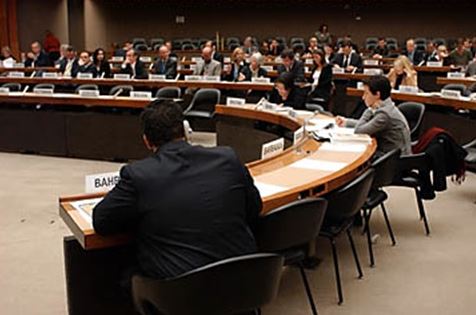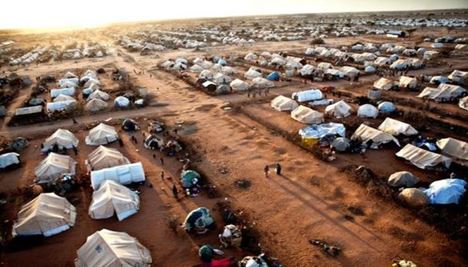Social Network
Facebook
Twitter
Instagram
|
UNHRC
UNITED NATIONS HUMAN RIGHT COUNCIL
Topic: Strengthening the international response to internally displaced persons: natural disasters and internal displacement.
It is notable how natural disasters have increased in the last 30 years. In the 1970s, the average of these events was 90 per year. In the 1990s, this number rose to 260 per year. These figures directly reflect the increase in the frequency and intensity of disasters caused by severe storms, earthquakes, tsunamis, floods, mudslides, droughts and erosions. Mainly after the Tsunamis, hurricanes and earthquakes which hit parts of Asia and Americas in 2004 and 2005, as well as the Haiti and Chile earthquakes of 2010, multiple Human Rights challenges in consequence of natural disasters are posed, such as: the lack of security and safety; the increase of violence; the unequal access of basic goods, public services and humanitarian aid; the social discrimination due to contagious diseases; the family forced separation; and the inadequacy of local law to deal with these situations (YONETANI, 2012).
According to a publication of the Internal Displacement Monitoring Centre (IDMC), from 2008 to 2012 there were at least 144 million displaced people by disasters, and 32.4 million of them were displaced during 2012. The same publication shows that 98% of displacement is a result of climate hazards. Also important is that most of these movements occur in Asia and more recently, in Africa: “While over the past five years 81% of global displacement occurred in Asia, in 2012 Africa had a high record for the region of 8.2 million people newly displaced, over four times more than in any of the previous four years” (IDMC, 2013).
The concept of displaced people emerged in the 1990s, moment in which more populations were being uprooted due to ethnic strife and armed conflicts, where several situations of human rights abuse emerged. IDMC defines an internally displaced person (IDP) as “persons or groups of persons who have been forced or obliged to flee or to leave their homes or places of habitual residence, in particular as a result of or in order to avoid the effects of armed conflict, situations of generalized violence, violations of human rights or natural or human-made disasters, and who have not crossed an internationally recognized State border” (IDMC, 2004).
It is important to distinguish an IDP from a refugee. The United Nations Convention relating to the Status of Refugees (1951) defines refugees as people who are outside their country of nationality and are unable to return because of a well-founded fear of persecution for any type of reasons, such as race, religion, nationality, being member of particular social group or political opinion (UNITED NATIONS GENERAL ASSEMBLY, 1951).
It means that, differently from refugees, displaced persons still keep their rights of protection conceded by their State as they remain inside national borders, maintaining the status of citizens of the country (IDMC, 2012). In other words, IDPs are taken from their homes but do not leave the territory of their State, while refugees usually cross internationally recognized borders, no longer being under protection of their original country. However, while refugees can count on several international instruments which define their status, IDPs still lack a comprehensive international framework to protect their rights. Furthermore, existing mechanisms on the subject are ineffective and insufficient, especially in reference to displacements caused by natural disasters (IDMC, 2012).
Thus, it is of extreme importance that the United Nations Human Rights Council discusses preventative measures to violations of IDPs human rights caused by natural disasters in order to develop suitable ways to deal with this type of situation. Other relevant aspects must be addressed, such as types of durable solutions in which States can provide social stability to displaced persons; ways to guarantee the free access to justice for displaced persons; the total respect of the principle of non-discrimination; and the protection of their basic civil rights, particularly those stated in the Universal Declaration of Human Rights.
Finally, the intention of the United Nations Human Rights Council is to achieve a fruitful debate and a compromise along the proposed themes, such as a common definition regarding the possibility of a specific category of IDP, including the specific problems caused by climate hazards; and defining obligations and conditions to protect IDP human rights through a multilateral Plan of Action.
 Image 1
Image 1
OFFICE OF THE HIGH COMMISSIONER FOR HUMAN RIGHTS. United Nations Human Rights Council, 2013. Available at: <http://www.ohchr.org/EN/HRBodies/HRC/Pages/HRCIndex.aspx>. Access: 30 May.2013.
 Image 2
Image 2
KERR, Á Ine. Over 702,000 Somalis flock to refugee camps. Storyful, 9th October 2011. Available at: <http://storyful.com/stories/8826>. Access: 30 May 2013
REFERENCES
IDMC, “Global Estimates 2012: People displaced by disasters”. May 13, 2013. Available at: <http://www.internal-displacement.org/natural-disasters>. Access: 30 Mar. 2013.
YONETANI, Michelle. Global Estimates 2011: People Displaced by natural Hazard-induced
disasters. Norwegian Refugee Council, 2012. 25 p. Available at:
<http://www.internal-
displacement.org/8025708F004BE3B1/(httpInfoFiles)/
1280B6A95F452E9BC1257A22002DAC12/$file/global-estimates-2011-natural-disasters-jun2012.pdf>. Access: 25 May. 2013
INTERNAL DISPLACEMENT MONITORING CENTRE (IDMC). Who is an Internally Displaced Person? The definition of an internally displaced person. Internal Displacement, 2004. Available at:
<http://www.internal-displacement.org/8025708F004BE3B1/(httpInfoFiles)/
8FA27BA51F738586C125711500467CD2/$file/Definition%20module%20handout.pdf>.
Access: 20 Apr. 2013.
UNITED NATIONS GENERAL ASSEMBLY. Convention Relating to the Status of Refugees. United Nations High Commissioner for Refugees. 1951.
Available at: <http://www.refworld.org/cgi-bin/texis/vtx/rwmain?page=search&docid=3be01b964&skip=0&query=GENEVA
%20CONVENTION%20RELATING%20TO%20THE%20STATUS%20OF%20REFUGEES>.
Access: 22 Apr. 2013. |









